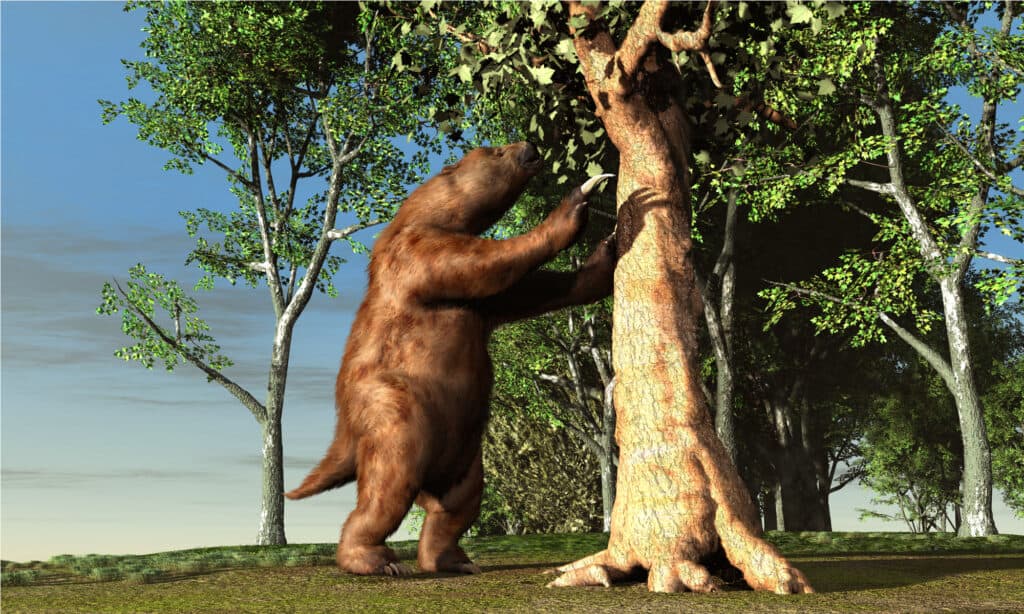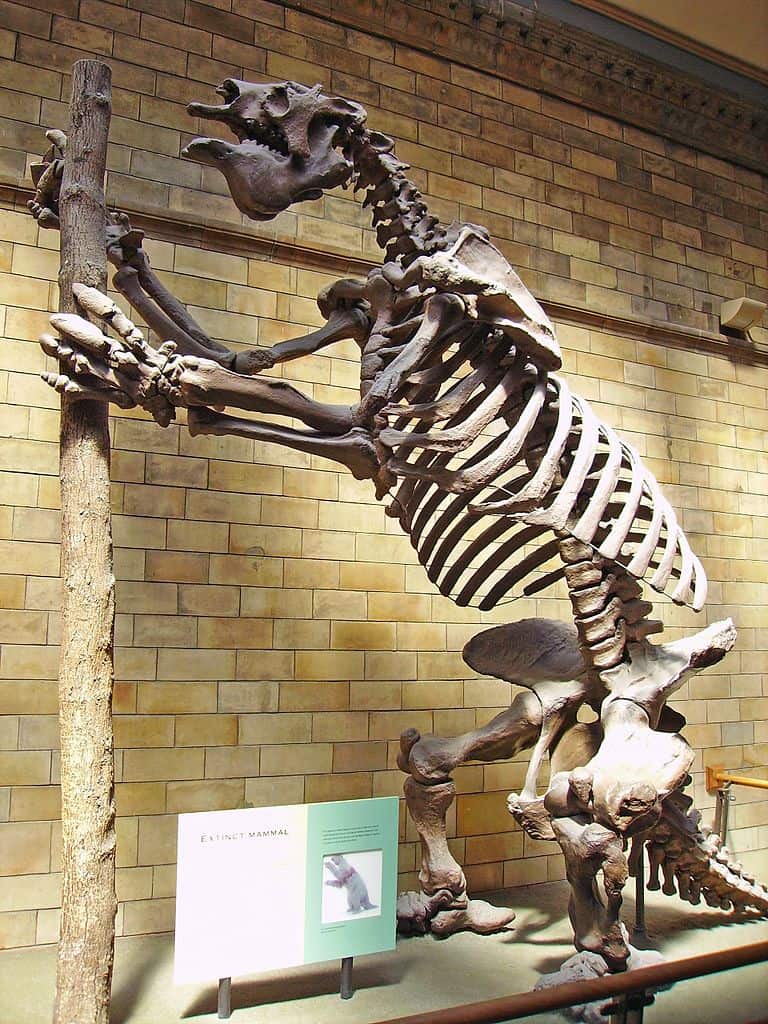Megatherium
M. americanum
Megatherium probably used its lips more than its tongue when feeling for choice leaves in the treetops.
Advertisement
Megatherium Scientific Classification
- Kingdom
- Animalia
- Phylum
- Chordata
- Family
- Megatheriidae
- Genus
- Megatherium
- Scientific Name
- M. americanum
Read our Complete Guide to Classification of Animals.
Megatherium Conservation Status
Megatherium Facts
- Group Behavior
- Solitary/Group
- Fun Fact
- Megatherium probably used its lips more than its tongue when feeling for choice leaves in the treetops.
- Biggest Threat
- Humans
- Most Distinctive Feature
- Seven-inch claws
Megatherium Physical Characteristics
View all of the Megatherium images!
Looking at present-day sloths, it’s hard to imagine that at one point a giant slot—the Megatherium—was among the biggest land mammals to roam the Earth.

Classification and Evolution
Megatherium americanum, the “great beast from America,” is the only species of giant ground sloth from the Megatherium genus. This mammal belonged to the SuperOrder Xenarthra, comprised of the Order Cingulata (armadillos) and the Order Pilosa, which includes anteaters and sloths. It also belonged to the Clade Megatheria, Family Megatheriidae, and Subfamily Megatheriinae, all of which are extinct.
An ancestor of the Megatherium from the Miocine epoch is the Promegatherium, which was comparable in size to a rhinoceros. The Megatherium evolved to a larger size, so that by the late Pleistocene era, it was the size of an African elephant. The oldest fossils date back to about 3.58 million years ago, but the Megatherium did not become extinct until 8,000-12,000 years ago.
Description and Size
Modern sloths typically measure about 3 feet in length and weigh around 11 lbs., but researchers estimate that the Megatherium was up to 10 times larger.
Current fossil records indicate that this giant sloth reached weights of up to 4 tons (8,000 lbs.) and stood 12 feet tall when standing upright on its hind legs. Head-to-tail, Megatherium measured around six meters (20 ft.) on average.

©Esteban De Armas/Shutterstock.com
Its skeletal structure suggests that it walked long distances on all fours to distribute its weight evenly. But its short hind legs and wide pelvis also tell us that the Megatherium likely spent a lot of time standing and sitting back on its hind legs and short, thick tail.
One interesting characteristic of Megatherium anatomy is its enormous seven-inch claws. Because of its claw length, this giant sloth was unable to walk on the flats of its paws like other mammals. Instead, it walked on the sides of its feet, like the modern anteater.
The Megatherium had a strangely small head and mouth for such a large animal. In fact, among all other ground sloths that existed during the Pleistocene epoch, it had the narrowest mouth. It was larger in the back and narrowed down to the front in a cone shape. This likely meant that it was much more selective in the foliage it ate. This wouldn’t have been a problem because it would probably have reached higher in the trees than any other herbivore of its time.
Key characteristics of Megatherium:
- 36 feet long (6 meters) and weighed around 4 tons
- Stood 3 meters tall on its hind legs
- Spent much of its time resting on its haunches
- Had the narrowest mouth of any ground sloth of its time
- Walked on the sides of its paws instead of the bottoms
Diet
We know that the Megatherium was not a carnivore based on its mouth and tooth structure alone, and it probably wasn’t fast enough to be a predator anyway. At the same time, we do not have conclusive evidence that it was strictly a herbivore either.
Based on tooth remains that researchers have found, they know that the primary diet of the giant sloth was gritty and fibrous. With that said, it would have very little competition for food—even with many other herbivores around. Not only would it have been capable of eating low vegetation or digging for roots, but it could have reached higher than most other plant-eaters.
There are theories that the Megatherium may have also eaten meat to supplement its diet. Some say this could have simply been scavenging animal corpses. However, it also had the size to kill other herbivores.
Some of these theories began with Richard Fariña, a paleontologist from Montevideo University of the Republic. At one point, he agreed with the common consensus that the Megatherium was a herbivore. However, according to fossil records, the South American steppes where the giant sloth lived were home to many herbivores. So, because there were very few carnivores present, Fariña speculated that the environment couldn’t have supported the number of herbivores, and he suspected that Megatherium may have been an omnivore.
This isn’t proof in itself because no fossil evidence supports it. But it’s an interesting theory that the fossil record doesn’t deny, either.
Habitat

Megatherium americanum got its name from having lived in South America.
©iStock.com/CoreyFord
Just like its modern descendent, the tree sloth that’s currently confined to South and Central America, Megatherium remains have been found in several countries in South America. Researchers believe this ground sloth would have traveled extensively throughout South and Central America.
Based on the fossil remains uncovered by researchers, it is estimated that Megatherium lived during the Middle Pleistocene through to the start of the Holocene, approximately 400,000 up until around 8,000 years ago.
Threats And Predators
One thing that the Megatherium would never have had to worry about was running out of food. Even if other mammals ate all the ground vegetation, it would have always had the treetops as an option.
Also, because of where and when the Megatherium lived, there were not actually a lot of predators that would have been capable of bringing it down. There is no fossil evidence to tell us what animals would have threatened this species.
One possibility is the Homotherium, or as many people know them, the scimitar-toothed cat. This fearsome cat likely hunted in packs. Even though they weren’t as big as an average adult human, they could bring down prey much larger than themselves.
One fascinating thing about predators that doesn’t come up very often when talking about prehistoric or ancient species is the threat of humans. However. because Megatherium fossils have been dated as young as 8,000 to 7,000 years ago, it doesn’t come as a big surprise we’ve found evidence of humans hunting these giant ground sloths.
In 2017, researchers discovered over 100 tracks in the White Sands. These footprints told a story of a battle between a Megatherium and a human. In addition, there have been fossils recovered that have cuts on them. This is enough to tell that this massive beast was likely on the menu several thousand years ago.
Discoveries and Fossils

Fossils from Megatherium americanum, “the beast from America,” were first discovered in Argentia in 1978.
The first Megatherium fossils were discovered in Argentina by Manuel Torres in 1978. He uncovered them along the edge of the Luján River. A year later, Torres sent the fossils to Madrid, and the original skeleton is currently displayed there at the Museo Nacional de Ciencias.
Since Torres uncovered the first Megatherium fossils, researchers have discovered several other specimens across South America. Some notable places are Bolivia, Brazil, Peru, Uruguay, Argentina, and Columbia.
In 2004 and 2006, researchers thought they may have discovered two new Megatherium subspecies; M. urbinai and M. celendinense. However, these subspecies were considerably smaller, and researchers assigned them their own subgenus: Pseudomegatherium.
Extinction
According to much of the fossil evidence, researchers suspect that most of Megatherium likely started dying out around 12,000 years ago during the end of the Cenozoic era during the Quaternary period. Most researchers agree on two significant factors to the Quaternary extinction event: climate change and humans.
The Quaternary period was filled with changes in the climate. In South America, where the Megatherium lived, temperatures would have likely fluctuated dramatically and become colder and more arid. This giant sloth didn’t go down without a fight because we know that it lasted for many more years. The strongest were able to adapt to a certain degree.
However, then came humans. Footprint and fossil discoveries show that humans hunted the giant ground sloth. Many researchers agree that that was the main factor in their demise, as was the case for hundreds of other species worldwide in those changing times.
One interesting thing worth noting is that there is some speculation that the Megatherium is not entirely extinct. Some stories in South America of a giant beast still roaming the Amazon rainforest match the description reasonably well that we have of the giant ground sloth. There is no conclusive evidence, but it’s an exciting thought.
Similar Animals
Read more about some similar animals to the Megatherium:
- Eremotherium: The Eremotherium is another genus of ground sloths living before and alongside Megatherium. The genus has three species: E. laurillardi, E. rusconi, and E. eomigrans. Fossil records show that this sloth lived around 2 to 1.6 million years ago up until approximately 11,000 years ago.
- Paraceratherium: The Paraceratherium is a genus of hornless rhinos. It was originally discovered in what’s now Pakistan. While it wouldn’t have lived alongside the giant ground sloths, it would have been a similar size—albeit much heavier at 15 to 20 tons.
- African Bush Elephant: It’s one thing to look at fossils and imagine how large Megatherium would have been, but it’s another to look at a living animal that is a comparable size. That’s what we get when we look at the African bush elephant. This is the largest living elephant today. Sizewise, it’s comparable to what the average Megatherium would have been.
Megatherium FAQs (Frequently Asked Questions)
When was the Megatherium Alive?
According to the available fossil records, researchers estimate that Megatherium was alive from the Middle Pleistocene to the start of the Holocene. This was around 400,000 years ago, up to approximately 8,000.
How Big was Megatherium?
The average Megatherium weighed around 4 tons and measured about six meters from head to tail. When it stood upright on its big hind legs, it would have likely been able to reach over three meters in the air.
Thank you for reading! Have some feedback for us? Contact the AZ Animals editorial team.
Sources
- National History Museum / Accessed June 14, 2022
- Discovery Magazine / Accessed June 14, 2022
- Science Organization / Accessed June 14, 2022
- Bio One / Accessed June 14, 2022

















